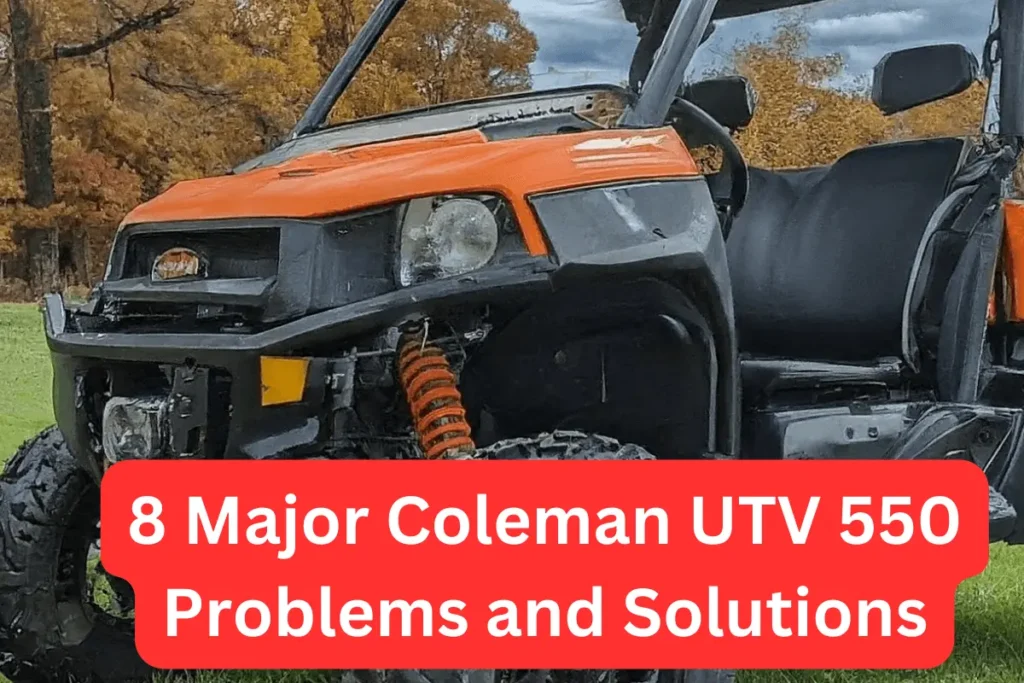The most common John Deere Gator 625i problems are engine not starting, electrical issues, PTO problems, clutch issues, brake problems, transmission problems, door issues, fuel leaks issues and running rough issues.
Here I discuss the problems in detail along with their easy solutions. I provide their details in a way that a non-technical person also understands.
10 John Deere Gator 625i problems
Now it is a time to explore the 10 most common problems with John Deere Gator 625i. You can also explore the John Deere Gator 620i problems.
1. Engine Not Starting
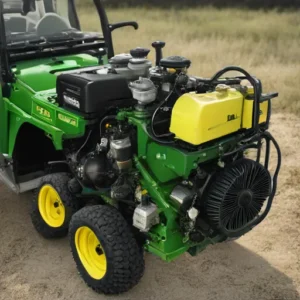
I understand how frustrating it can be when your vehicle won’t start, especially if you’re not familiar with the technical aspects. Here are some issues due to which your UTV engine won’t start.
I. Fuel System Issues
One common reason for engine starting problems is related to the fuel system. Here are a few possible issues and their solutions:
1.1. Empty Fuel Tank
It may seem simple, but sometimes the fuel tank is empty. Check the fuel gauge or look at the tank to make sure there’s enough fuel. If the tank is empty, fill it up and try starting the engine again.
1.2. Clogged Fuel Filter
A clogged fuel filter can stop fuel from getting to the engine. If your Gator has been running for a while or if you suspect a clogged filter, it’s worth checking and replacing it if necessary. Refer to your vehicle’s manual for the location of the fuel filter and follow the instructions provided.
1.3. Faulty Fuel Pump
If the fuel pump is not functioning properly, it may not be supplying enough fuel to start the engine. You can check the fuel pump by listening for a humming sound when you turn the ignition on. If you don’t hear anything, it might suggest a faulty fuel pump that needs replacing.
II. Electrical System Issues
The electrical system plays a crucial role in starting the engine. Here are a few electrical problems you may encounter and their solutions:
2.1. Dead Battery
A dead or discharged battery is a common reason for engine starting issues. Check the battery voltage using a multimeter. If the voltage is below the recommended level, you might need to recharge or replace the battery. Keep in mind that batteries have a limited lifespan, so it’s normal for them to eventually require replacement.
2.2. Loose or Corroded Battery Connections
Check the battery terminals and cables for any signs of corrosion or looseness. Corrosion can prevent proper electrical contact, while loose connections can result in intermittent power supply. If needed, clean the terminals and securely tighten the connections.
2.3. Faulty Ignition Switch
If the ignition switch is faulty, it may not send the necessary electrical signals to start the engine. You can test the ignition switch using a multimeter or consult a professional for assistance. If the switch is indeed faulty, it will need to be replaced.
III. Engine Mechanical Issues
In some cases, the engine itself may be the source of the starting problem. Here are a couple of mechanical issues to consider:
3.1. Spark Plug Problems
Check the spark plugs for any signs of wear, damage, or fouling. If the spark plugs are worn out or covered in deposits, they may not ignite the fuel-air mixture properly, leading to starting issues. Replace the spark plugs if necessary and ensure they are properly gapped according to the manufacturer’s specifications.
3.2. Engine Compression Issues
When the engine has low compression, starting can be a challenge. Low compression can be caused by various factors, such as worn piston rings or leaking valves. This is a more intricate problem that might need professional diagnosis and repair.
2. PTO Issues

The PTO is a mechanical device that transfers power from the engine to another machine or attachment. In the case of the John Deere Gator 625i, the PTO is responsible for powering accessories such as mowers, sprayers, and snow blowers. It’s an essential component that ensures the efficient operation of these attachments. Also explore the John Deere Gator 825i problems.
I. PTO Not Engaging
One of the most common issues with the PTO is when it fails to engage. If you’re experiencing this problem, there are a few things you can check. First, inspect the PTO switch and ensure that it is in the “ON” position.
Next, check the wiring connections to make sure they are secure and not damaged. If everything looks fine, it’s possible that the PTO clutch is worn out and needs to be replaced. In this case, it’s best to consult a qualified technician to handle the replacement.
II. PTO Engages but Doesn’t Turn
Another problem you might encounter is when the PTO engages, but the accessory or attachment doesn’t turn. This issue could be caused by a few different factors. First, check the PTO belt for any signs of wear or damage. If the belt is worn or broken, you’ll need to replace it.
Additionally, inspect the PTO pulley and make sure it is properly aligned and not damaged. If the belt and pulley are in good condition, the problem may lie with the PTO clutch or the attachment itself. In this case, it’s recommended to seek professional assistance to diagnose and fix the issue.
III. PTO Disengages Unexpectedly
If your PTO disengages unexpectedly while in use, it can be quite frustrating. This problem can result from a variety of factors. First, check the PTO switch and ensure that it is securely in the “ON” position. If the switch is loose or faulty, it may disengage the PTO unintentionally.
Additionally, inspect the wiring connections to make sure they are tight and not damaged. If the switch and wiring are in good condition, the problem may be with the PTO clutch. A worn-out clutch can cause the PTO to disengage unexpectedly, and it will require replacement.
3. Fuel Leaks Issues

The first step in addressing a fuel leak issue is to identify its source. Here are a few common signs that indicate a fuel leak in your Gator:
- Strong smell of gasoline
- Puddles of fuel underneath the vehicle
- Decreased fuel efficiency
- Visible cracks or damage to fuel lines or connections
Possible Causes of Fuel Leaks
Now that you know how to identify a fuel leak, let’s explore some of the possible causes:
- Worn or damaged fuel lines: Over time, fuel lines can become worn, cracked, or damaged, leading to leaks.
- Loose or faulty fuel connections: If the connections between the fuel lines and the fuel tank or engine are loose or faulty, fuel can leak out.
- Failed fuel injector seals: The fuel injector seals can deteriorate over time, causing fuel to leak from the injectors.
- Cracked fuel tank: A cracked fuel tank can lead to fuel leakage.
- Improperly installed or damaged fuel cap: If the fuel cap is not properly installed or damaged, it can cause fuel to leak.
Solutions to Fuel Leak Issues
Now that we’ve identified the possible causes of fuel leaks, let’s discuss some solutions:
1. Inspect and Replace Worn or Damaged Fuel Lines
Regularly inspect the fuel lines for any signs of wear, cracks, or damage. If you notice any issues, replace the fuel lines with new ones. Ensure that the new fuel lines are compatible with your John Deere Gator 625i model.
2. Check and Tighten Fuel Connections
Inspect the connections between the fuel lines, fuel tank, and engine. If you find any loose or faulty connections, tighten them or replace them if necessary. Use the appropriate tools and follow the manufacturer’s instructions for proper tightening.
3. Replace Failed Fuel Injector Seals
If you suspect that the fuel injector seals are causing the leak, it’s best to replace them. Consult your John Deere Gator 625i’s user manual or seek professional assistance to ensure a proper replacement.
4. Repair or Replace Cracked Fuel Tank
If you have a cracked fuel tank, it’s crucial to repair or replace it. Depending on the extent of the damage, you may need to consult a professional or authorized John Deere service center for assistance.
5. Replace Damaged or Improperly Installed Fuel Cap
If your fuel cap is damaged or not properly installed, it can cause fuel leaks. Replace the fuel cap with a new one that is compatible with your John Deere Gator 625i. Ensure that it is securely tightened to prevent any leaks.
4. Transmission Issues
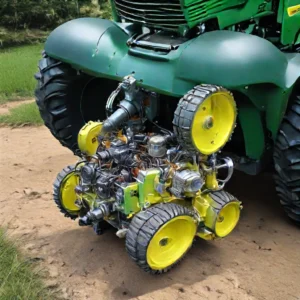
Here are some john deere gator 625i transmission problems.
I. Shifting Problems
One of the most common transmission issues in the John Deere Gator 625i is difficulty in shifting gears. You may experience grinding or resistance when trying to shift from one gear to another. This can make it challenging to operate your Gator smoothly.
The possible causes for shifting problems can be a worn-out clutch, incorrect clutch adjustment, or a damaged shift fork. To resolve this issue, you should:
- Inspect the clutch for signs of wear and replace if necessary.
- Ensure the clutch is properly adjusted according to the manufacturer’s specifications.
- Check the shift fork for any damage and replace if needed.
II. Slipping Transmission
Another issue you may encounter is a slipping transmission, where the Gator fails to maintain power or speed while driving. This can be a safety concern and may affect the overall performance of your vehicle.
The potential causes of a slipping transmission include low transmission fluid level, worn-out transmission belts, or a faulty torque converter. Here’s what you can do to address this problem:
- Inspect the transmission fluid level and add more if needed. Also, inspect for any leaks and repair them.
- Inspect the transmission belts for signs of wear or damage and replace them if needed.
- If the slipping persists, it may indicate a faulty torque converter. In this situation, it’s best to consult with a professional mechanic for a thorough diagnosis and repair.
III. Overheating Transmission
An overheating transmission is a serious concern that can lead to severe damage if not addressed promptly. You may notice the transmission temperature warning light illuminating or experience a burning smell while operating your Gator 625i.
The common causes of an overheating transmission include low transmission fluid, a malfunctioning cooling system, or excessive towing or hauling. To prevent and address this issue, follow these steps:
- Verify the transmission fluid level and make sure it’s at the recommended level. If low, top it up with the appropriate fluid.
- Inspect the cooling system, including the radiator and cooling fan, for any obstructions or damage. Clean or repair as necessary.
- Avoid excessive towing or hauling, as it can put additional strain on the transmission. If you regularly engage in heavy-duty tasks, consider installing an aftermarket transmission cooler to improve cooling efficiency.
5. Brake Problems
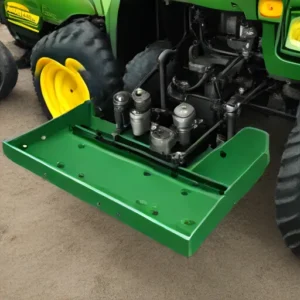
Here are some common signs that indicate brake problems:
- If the brake pedal feels spongy or goes to the floor, it could be a sign of air in the brake lines or brake fluid leak.
- Brakes are not responsive or take longer to engage
- When applying the brakes the unusual noises comes, such as squeaking or grinding,
- Brake warning light is illuminated on the dashboard
If you experience any of these symptoms, it is important to address the issue promptly to ensure your safety and the proper functioning of your Gator 625i.
I. Worn Brake Pads
Worn brake pads are one of the most common brake problems. Over time, the brake pads can become thin and lose their effectiveness. To resolve this issue, follow these steps:
- Locate the brake caliper on each wheel.
- Remove the caliper bolts and slide out the old brake pads.
- Check the brake rotor for any indications of damage or excessive wear.
- If the rotor is in good condition, install new brake pads.
- Reinstall the caliper and tighten the bolts securely.
Regularly inspecting and replacing worn brake pads will ensure optimal braking performance and safety.
II. Brake Fluid Leaks
Brake fluid leaks can lead to a loss of braking power and require immediate attention. Here’s what you can do:
- Examine the brake lines and connections for any signs of leakage.
- If you find a leak, identify the source and assess the severity.
- Depending on the extent of the leak, you may need to replace the damaged brake line or tighten loose connections.
- Refill the brake fluid reservoir with the recommended fluid.
- Bleed the brake system to eliminate any air bubbles.
Regularly checking for brake fluid leaks and addressing them promptly will help maintain the integrity of your braking system.
III. Brake Rotor Warping
Brake rotor warping can cause vibrations and uneven braking. Follow these steps to resolve the issue:
- Remove the wheel to access the brake rotor.
- Inspect the rotor for signs of warping, such as uneven wear or grooves.
- If the rotor is warped, it may need to be resurfaced or replaced.
- Install a new rotor or resurface the existing one, following the manufacturer’s guidelines.
- Reinstall the wheel and ensure it is properly tightened.
Addressing brake rotor warping will improve the overall braking performance and prevent premature wear of brake components.
6. Electric Issues
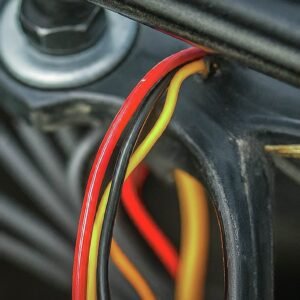
Here are some common problems you might face:
- Dead Battery: If your Gator is not starting or is experiencing intermittent electrical problems, a dead battery could be the culprit.
- Blown Fuses: If specific electrical components like lights or the horn aren’t functioning, a blown fuse might be the cause.
- Wiring Problems: Loose or damaged wiring can cause a variety of electrical issues, such as flickering lights or malfunctioning gauges.
- Faulty Switches: If you are unable to turn on or off certain electrical features, the switches may be faulty and in need of replacement.
Solutions to Electric Issues
Now that we have identified some common electric issues, let’s discuss the solutions to these problems:
1. Dead Battery
If you suspect that your Gator’s battery is dead, the first step is to check the battery voltage using a multimeter. A fully charged battery typically reads around 12.6 volts. If the voltage is significantly lower, it’s time to recharge or replace the battery. Make sure to check the battery connections for any corrosion or loose connections as well.
2. Blown Fuses
When dealing with blown fuses, it’s important to locate the fuse box in your Gator. Check the owner’s manual to find its exact location. Once you have found the fuse box, inspect the fuses for any signs of damage or a broken filament. Replace any blown fuses with new ones that have the same amperage rating. It’s also a good idea to check the wiring connected to the fuse box for any loose connections or damage.
3. Wiring Problems
If you suspect wiring problems, start by visually inspecting the wiring harnesses for any signs of damage, such as frayed or exposed wires. Repair or replace any damaged wiring as necessary.
Also, make sure all connections are tight and clean from corrosion. If the problem continues, it’s advisable to seek assistance from a professional technician for a thorough diagnosis and repair.
4. Faulty Switches
When dealing with faulty switches, it’s important to identify which specific switch is causing the issue. Once identified, you can replace the faulty switch with a new one. Be sure to follow the manufacturer’s instructions for correct installation. If you are unsure about replacing the switch yourself, it’s always best to seek assistance from a qualified technician.
7. Clutch Issues with the John Deere Gator 625i
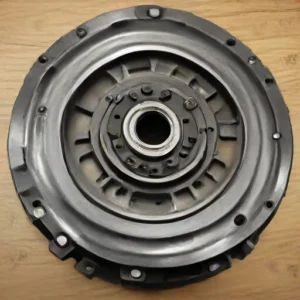
Here are few signs of clutch issues with the John Deere Gator 625i.
Problem 1: Clutch Slipping
One of the most common clutch issues that can occur with the John Deere Gator 625i is clutch slipping. You may notice that the engine revs up, but the vehicle does not accelerate as it should. This can be frustrating and potentially dangerous, especially when driving on uneven terrain.
The solution to this problem is often a simple adjustment of the clutch cable. Start by locating the clutch cable on your Gator 625i. It is typically found near the engine, running to the clutch assembly. Inspect the cable for any indications of wear or damage.
If the cable looks fine, you can try tightening it slightly to increase the clutch engagement. However, be careful not to overtighten it, as this can cause the clutch to drag.
Problem 2: Clutch Noise
Another common issue that Gator 625i owners may encounter is clutch noise. This can manifest as a grinding or squealing sound when engaging or disengaging the clutch. Clutch noise can be bothersome and may indicate a problem with the clutch components.
To address this issue, it is important to inspect the clutch components for any signs of wear or damage. Start by checking the clutch plates for excessive wear or warping. If the plates are worn or damaged, you’ll need to replace them..
Additionally, check the clutch springs for proper tension and replace any that are loose or broken. Proper lubrication of the clutch components can also help reduce noise. Be sure to use a lubricant recommended by the manufacturer.
Problem 3: Clutch Engagement Issues
Some Gator 625i owners may experience problems with clutch engagement. This can manifest as difficulty shifting gears or a delay in power delivery when accelerating. These issues can make it challenging to operate the vehicle smoothly.
One possible solution to this problem is to adjust the clutch pedal free play. Start by locating the clutch pedal under the dashboard of your Gator 625i. The free play refers to the distance the pedal can move before it starts to engage the clutch. Adjusting the free play can help ensure proper clutch engagement. Consult the owner’s manual or a qualified technician for specific instructions on how to adjust the clutch pedal free play for your model.
Another potential solution is to check the clutch fluid level. Low clutch fluid can cause engagement issues. Locate the clutch fluid reservoir, usually located near the brake fluid reservoir, and check the fluid level. If it’s low, fill it up with the recommended fluid. If the fluid level is consistently low, there may be a leak in the clutch system that needs to be addressed by a professional.
8. Door Issues

Here are some John Deere Gator 625i door problems.
Problem 1: Difficulty in Opening or Closing Doors
One of the most common door issues with the John Deere Gator 625i is difficulty in opening or closing the doors. This can be frustrating and may hinder your overall experience with the vehicle.
Solution:
First, check if there is any debris, dirt, or rust around the door hinges. Clean the hinges thoroughly and lubricate them with a suitable lubricant to ensure smooth movement.
Additionally, inspect the door latch mechanism for any signs of damage or misalignment. If necessary, adjust or replace the latch to ensure proper functioning.
Problem 2: Door Misalignment
Another common issue is door misalignment, where the door may not fit properly or may have gaps when closed. This not only affects the aesthetics but also compromises the vehicle’s safety and security.
Solution:
Start by checking if the door hinges are loose. If needed, tighten them to ensure they fit securely. If the misalignment persists, inspect the door frame for any signs of damage or bending. In such cases, it may be necessary to replace the door frame or seek professional assistance to realign it correctly.
Problem 3: Water Leakage
Water leakage through the doors can be a significant concern, especially during rainy or wet conditions. It can lead to discomfort, damage to the interior, and potential electrical issues.
Solution:
Check the door seals for any signs of wear or damage. Replace the seals if necessary, ensuring a proper and watertight fit. Additionally, check for any gaps or cracks in the door panels and repair them using appropriate sealants. Regularly maintaining the door seals and panels will help prevent water leakage and ensure a dry and comfortable cabin.
Problem 4: Door Rattling or Vibrations
If you notice excessive rattling or vibrations coming from the doors while driving, it can be both annoying and concerning. This issue may affect your overall driving experience and potentially indicate a loose or damaged component.
Solution:
Inspect the door hinges, latch, and other fasteners for any signs of looseness. Tighten them if necessary to eliminate any rattling or vibrations. Additionally, check for any worn-out or damaged door components, such as handles or latches, and replace them as needed. Regularly inspecting and maintaining these components will help ensure a smooth and comfortable ride.
9. Running Rough

When your John Deere Gator 625i is running rough, there could be several potential problems causing this issues.
Fuel System Issues
The fuel system is a critical component of your Gator’s performance. If there are any issues with the fuel system, it can result in rough running. Here are a few fuel system problems to consider:
- Clogged fuel filter: As time passes, the fuel filter can get clogged with dirt and debris, limiting the fuel flow to the engine. This can cause rough running and poor performance. The solution is to replace the fuel filter regularly as part of your maintenance routine.
- Fuel pump problems: A malfunctioning fuel pump can also lead to rough running. If the fuel pump is not delivering the proper amount of fuel to the engine, it can cause misfires and hesitation. In this scenario, the fuel pump may require repair or replacement.
- Dirty fuel injectors: Dirty fuel injectors can disrupt the fuel spray pattern, leading to rough running. Using a fuel injector cleaner can help remove deposits and improve fuel flow.
Ignition System Issues
The ignition system is responsible for creating the spark that ignites the air-fuel mixture in the engine. If there are any issues with the ignition system, it can result in rough running. Here are a few ignition system problems to consider:
- Worn spark plugs: Over time, spark plugs can wear out and become less effective at igniting the fuel. This can cause misfires and rough running. Replacing the spark plugs at the recommended intervals can help maintain smooth operation.
- Faulty ignition coil: The ignition coil generates the high voltage required to create a spark. If the ignition coil is faulty, it can result in weak or inconsistent sparks, leading to rough running. In this case, the ignition coil may need to be replaced.
- Ignition timing issues: Incorrect ignition timing can cause the spark to occur at the wrong time, resulting in rough running. Setting the ignition timing according to the manufacturer’s specifications can help fix this problem.
Air Intake System Issues
The air intake system plays a crucial role in delivering clean air to the engine. If there are any issues with the air intake system, it can affect the engine’s performance and result in rough running. Here are a few air intake system problems to consider:
- Clogged air filter: A clogged air filter can restrict the airflow to the engine, leading to rough running. Regularly inspecting and cleaning or replacing the air filter can help maintain optimal performance.
- Vacuum leaks: Vacuum leaks can introduce unwanted air into the engine, disrupting the air-fuel mixture and causing rough running. Inspecting the vacuum lines and gaskets for leaks and replacing any damaged components can help resolve this issue.
10. Engine Light Issues

Here are some engine light issues with your John Deere Gator 625i.
I. Loose Gas Cap
One of the most common reasons for the check engine light to come on in the John Deere Gator 625i is a loose gas cap. This may seem like a minor issue, but it can trigger the check engine light. The first thing to do is to check the gas cap and make sure it is tightened properly. If the cap is loose, simply tighten it until you hear a click.
II. Faulty Oxygen Sensor
Another common issue that can cause the check engine light to come on is a faulty oxygen sensor. The oxygen sensor gauges the oxygen level in exhaust gases and relays this data to the engine control unit.. If the sensor is not functioning properly, it can lead to incorrect fuel-air mixture and trigger the check engine light.
If you suspect a faulty oxygen sensor, it is recommended to take your John Deere Gator 625i to a qualified mechanic who can diagnose and replace the sensor if necessary. Replacing the oxygen sensor should resolve the issue and turn off the check engine light.
III. Malfunctioning Mass Air Flow Sensor
The mass airflow sensor measures the amount of air entering the engine and helps the engine control unit determine the correct fuel-air mixture. If the mass airflow sensor is malfunctioning, it can cause the check engine light to come on.
If you suspect a malfunctioning mass airflow sensor, you can try cleaning it with a mass airflow sensor cleaner. This can sometimes resolve the issue and turn off the check engine light. However, if cleaning the sensor does not work, it is best to consult a professional mechanic for further diagnosis and potential replacement of the sensor.
IV. Faulty Catalytic Converter
A faulty catalytic converter can also trigger the check engine light in the John Deere Gator 625i. The catalytic converter is responsible for reducing harmful emissions from the exhaust gases. If it is not functioning properly, it can lead to increased emissions and trigger the check engine light.
If you suspect a faulty catalytic converter, it is recommended to have it inspected and replaced by a qualified mechanic. Replacing the catalytic converter should resolve the issue and turn off the check engine light.
V. Loose or Damaged Wiring
Loose or damaged wiring can also cause the check engine light to come on. Electrical issues can disrupt the communication between various components of the vehicle’s engine control system and trigger the check engine light.
If you suspect loose or damaged wiring, it is best to have a professional mechanic inspect and repair the wiring. They will be able to identify any issues and make the necessary repairs to resolve the problem and turn off the check engine light.
John Deere Gator 625i Top Speed

The John Deere Gator 625i is a powerful utility vehicle designed for various off-road tasks. Its top speed can vary depending on several factors, including terrain, payload, and maintenance. However, on average, the rough top speed of the Gator 625i is around 25 to 30 miles per hour.
Conclusion:
By following these guidelines you can easily get rid of John Deere Gator 625i problems because here I provide the complete details even if you are beginner.
I hope you again come to this site to know about the problems of the other models of UTV like can am defender problems.

